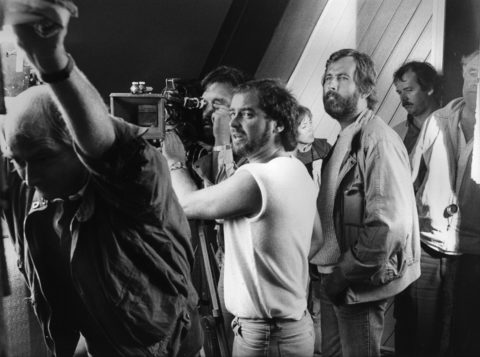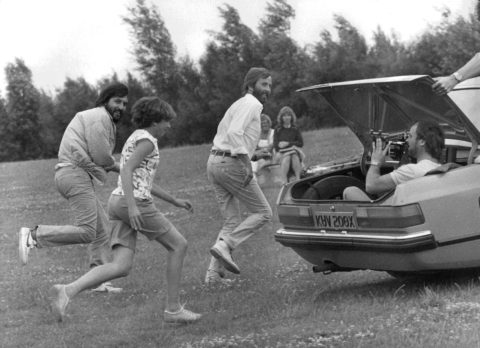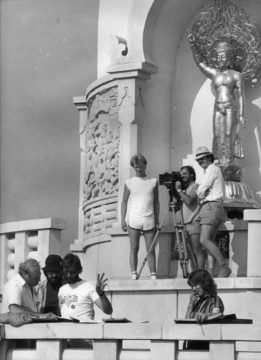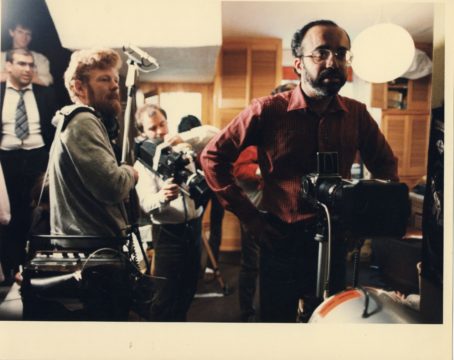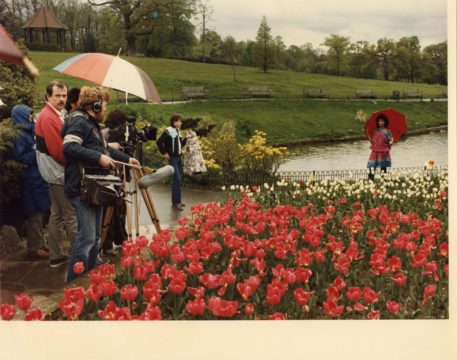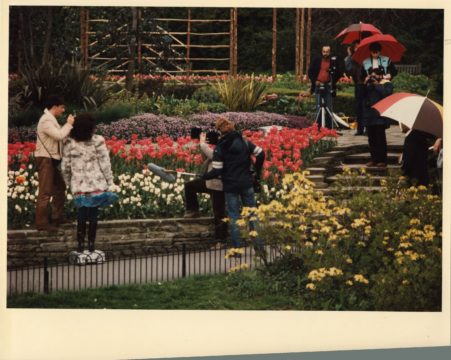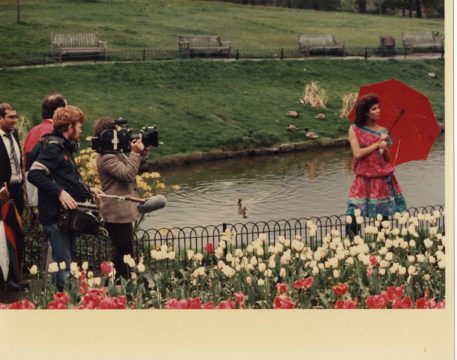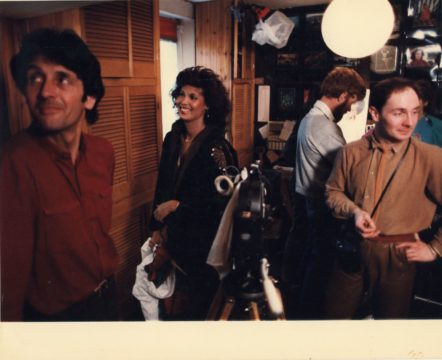
John shooting on Howards’ Way. Copyright resides with the original holder, no reproduction without permission

John filming on the crane. Copyright resides with the original holder, no reproduction without permission

John filming whilst sailing. Copyright resides with the original holder, no reproduction without permission

Cast and crew of Howards’ Way. Copyright resides with the original holder, no reproduction without permission
Below is an excerpt from cameraman, John Williams’ memoirs, Shoot First: No Ordinary Life. The Book is A4, 216 pages full colour, 96,500 words; it is being sold at cost £14, plus postage or can be collected.
If you would like a copy please contact John on
“Howards’ Way was a very popular series, so much so that one entrepreneurial chap ran boat trips from Southampton water up the Hamble to come and see us when we were in action at Burseldon. This was lovely but we would have to stop filming because the noise of the boats engine chugging towards us drove our sound recordists mad, we would look up to see hundreds of smiling faces all leaning over the side of the boat waving. This we called the ‘Howards’ Way Wave’, there wasn’t much we could do except to wave back and smile and stop for coffee. All through this series people were very friendly and support came from everywhere, not only the sailing fraternity. Stately homes like Waddesdon manor near Aylesbury and the beautiful Somerley house just north of Southampton, home of Lord Normanton and his family, threw open their doors as ideal make believe residences for some of the well heeled members of the cast. Even Cowes, with its famous Royal yacht Club, gave us time during their great events so I can only imagine we didn’t get it too badly wrong.
I loved every bit of the sailing possibly because I had gone from a twelve foot dinghy to finding myself on and off beautiful thirty plus foot yachts, I was in my element. The drama part of Howard’s Way was pure soap opera but the sailing was very real and came accompanied by excitement and its associated dangers. I have from a very early age a healthy respect for water, and especially the sea, my father having been to sea in his younger days. Knowing Bob Fisher from Top Sailing helped, he knew me and knew that I could sail and although we had a great unit and cast, few if any, had done any real sailing. I think a couple of days’ course was all they had, no wonder we had a few mishaps like throwing parts of lighting equipment overboard or people making innocent mistakes by trying to walk on the water. All survived but costume and makeup were not impressed nor I with the lights for that matter although, much to everyone’s surprise, once they had dried out they did work again. The lights that is, I’m not so sure about the artists!
It wasn’t only sailing yachts we used, large motor cruisers were often part of the scene. I thoroughly enjoyed all of it, Southampton was my second home on and off for five months of the year and, rather than go into the production hotel where I knew we would never get any peace, I plus my camera assistants David, Ian Churchill, Sue Cane or whoever was working with me at the time, would book into bedsits we had found for a more comfortable life.
The only down side to this was when a certain member was on the crew! Each evening after filming and after we had got safely back to our rooms, normally between seven and eight, he would insist on taking us to “The Duke Of Wellington” a pub around the corner. This had a sign outside and paintings on the walls inside of a gentleman that looked remarkably like one of our gaffer sparks, Arthur Haywood. He was dressed in the 1827 army uniform of a British General and we would comment on the likeness. There were two choices with an evening like this, suffer a lock-in at the pub and continue drinking after hours and paying the penalty of a hangover in the morning, or leave on the stroke of ten, the one that David and I used to try for, and go to the nearest Indian restaurant for a large curry and be prepared to suffer the consequences.
Thinking back I wonder that I am still here to tell these tales but perhaps outings like this made my constitution strong. That must be the answer, perhaps I should be grateful!!
Sue Cane a camera assistant often worked with me, not once complaining, unlike some of the others. One episode just before we were due to be filming in Malta, not the night shoot, David my operator fell ill and was replaced by Patti Musicaro, an assistant from BBC Ealing. It was all done at the last minute so we had not worked together before and, apart from Jimmy Monks my grip, I arrived much to everyone’s surprise with an all girl crew. It was a hectic shoot and all went well, but I do remember disappearing off most nights with Jimmy for a quiet drink in a local bar, only when we had finished filming did Patti tell me she had never operated on a drama before. Last I heard of her was, after being a very successful photographer, she was running her own Polygraph company and operates all over the world. Sue is still busy.
I enjoyed the experience of shooting “Howards’ Way” as did the millions of viewers that watched every Sunday night but it was not without its own tragedy. Maurice Colbourne, our leading actor, collapsed and died in France over one weekend. We had been filming in Burseldon on the Friday expecting him back on the Monday, I was told of his death when I arrived on the set on Sunday. Everyone was in shock but this was a genuine case where the show must go on and on it went. We carried on filming with the writers rewriting scripts but it was not the same. Finally London made the decision we would finish the series, but it would not be renewed.”
John Williams



